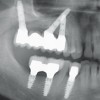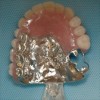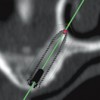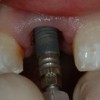This section contains a listing of the most significant references in the field of complete dentures.
REMOVABLE PARTIAL DENTURE LITERATURE REVIEW
Diagnosis and treatment planning
Bergman B. Periodontal reactions related to removable partial dentures: a literature review. JPD 1987;58:454-458.
- A RPD creates the potential for plaque formation and increases the risk for gingivitis and periodontitis. However it is possible to maintain the periodontal health with proper treatment and recall.
- If possible, the marginal gingiva should be left uncovered. When coverage is unavoidable, a slight relief should be provided.
- If there is good alveolar bone support of abutment teeth, if plaque control is established and if the prostheses are checked regularly, forces transmitted to abutment teeth do not seem to induce periodontal breakdown.
- Scientific documentation about the effects of RPDs in patients with extremely reduced periodontium is scanty.
Bergman B, Hugoson A, Olsson CO. A 25 year longitudinal study of patients treated with removable partial dentures. J Oral Rehab 1995;595-599.
Boero, E. and Forbes, W. G. Considerations in design of removable prosthetic devices with no posterior abutments. JPD 28:253-263, 1972.
Impressions
Feit DB. The altered cast technique revisited. JADA Oct 1999, 130(10): 1476-81.
Reviews the literature and describes a case report concluding that the altered cast improves fit and decreases the stresses on abutment teeth.
Frank RP, Brudvik JS, Noonan CJ. Clinical outcome of the altered cast impression procedure compared with use of a one-piece cast. JPD 2004;91:468-76.
72 patients with Kennedy class I mandibular RPDs assigned randomly for treatment using a one-piece or altered cast technique. The border extensions, base adaptation, amount of base movement, resorption of the edentulous ridge, tissue quality and sulcus depth, mobility and gingival index of the abutment teeth were evaluated. This was performed at insertion and again one year later. Underextension was noted in 22% of the one-piece cast and in none of the altered impression procedure. Otherwise, there was no difference between the two techniques provided that the following criteria are achieved: completely extended impression, use of magnification to adjust and ensure complete seating of the framework and coverage of the retromolar pad and buccal shelf by the base.
Hindels G. Load distribution in extension saddle partial dentures. JPD 1953;2:92-100.
Advocates a functional impression where the occlusal rest should be in position when the saddle is under a masticatory load and is seated on the fully displaced mucosa. Upon release of masticatory stress, the saddle will move occlusally with the rebounding tissues and the occlusal rest will lift slightly off the floor of the rest seat on the abutment tooth. Clasp arms should be designed and adjusted to allow for vertical movement of the saddle. A resin tray and zinc oxide eugenol is used to capture the soft tissue in a passive state. A second impression with alginate is used to capture the teeth and resin tray so that the mucosa is loaded.
Holmes JB. Influence of impression procedures and occlusal loading on partial denture movement. JPD 1965;15:474-481.
Three subjects were used to test three techniques for fabricating mandibular RPDs: 1) stock rim lock tray with irreversible hydrocolloid, 2) resin tray with irreversible hydrocolloid, 3) altered cast technique using irreversible hydrocolloid, rubber injection, metallic paste and Korecta-wax IV. Occlusal load was placed by suspending a four pound weight from a yoke on the first molar region. The movement of partial dentures from occlusal loading is related to the impression technique and the impression material used. The altered cast technique provided the least amount of movement from occlusal loading at the time of insertion.
Leupold RJ, Kratochvil FJ. An altered-cast procedure to improve support for removable partial dentures. JPD 1965;15:672-678.
Advocates capturing edentulous ridges in an undistorted state. The metal framework is fabricated on a cast made from an impression obtained from alginate in a metal stock tray. A resin tray over the edentulous areas is made and a wax spacer is provided. The borders are molded with compound and an impression of the tissue is made using zinc oxide eugenol paste. Pressure is maintained on the metal and not applied over the edentulous ridge.
Leupold RJ, Flinton RJ, Pfeifer DL. Comparison of vertical movement occurring during loading of distal extension removable partial denture bases made by three impression techniques. JPD 1992 Aug; 68(2): 290-293.
Reported that the movement under the RPD fabricated with the altered cast technique was the lowest of those tested; however, concluded that while the 0.19mm difference in movement between the altered cast RPD and the border molded polysulfide solid cast RPD was statistically significant, it was not clinically significant.
Preiskel HW. Impression techniques for attachment retained distal extension removable partial dentures. JPD 1971;25:620-627.
The basic problem of partial denture stabilization is to equalize the resilient and nonresilient support. Three general methods have been developed for treating the distal extension partial denture condition:
- Stress breakers, mechanical devices or flexible wrought wire connectors
- Functional impressions
- Recording the mucosa in a compressed or displaced state by one impression and then relating it to the abutment teeth by means of a secondary impression
- The mucosa always tries to return to its normal anatomic and physiologic state and introduces forces under the saddle which are dislocating in nature
- Applegate used mouth temperature wax to record the tissues in functional form. Others used wax or compound
- Broad stress distribution
- For a one piece impression, the hard and soft tissues are captured at rest. Under function, the occlusal rest will act as a stop and the load is applied to the distal end of the saddle. The result will be a traumatic load to the bone underlying the distal end of the saddle and to the abutment tooth, which, in turn, will result in bone loss and loosening of the abutment tooth.
Altered cast (Applegate first used altered cast, Leupold first wrote about it)
- Holmes 1965, Leupold & Kratochvil 1965, Leupold 1966, Hindels 1952
Direct and indirect retainers
Avant WE. Fulcrum and retention lines in planning removable partial dentures. JPD 1971;25:162-166.
A fulcrum line is an imaginary line passing through vertical stops on teeth. A retention line is an imaginary line passing through retentive points of two clasps. In some instances, moving the fulcrum line anteriorly and clasping the teeth in sequence will provide improved esthetics and additional soft-tissue support for the denture bases.
Brudvik JS & Wormley JH. Construction techniques for wrought wire retentive clasp arms as related to clasp flexibility. JPD 1973;30:769.
Measured the deflection of wire samples to a constant load. Approaches to construction of the wrought wire clasp arm: 1) cast to, 2) soldered to the minor connector, 3) soldered to the base retentive mesh area, 4) attached only in the resin of the denture base. According to in vitro testing, wrought-wires soldered on the base retentive mesh are more flexible than “cast to” wires or wires soldered to the minor connector.
Cecconi BT, Asgar K, Dootz E. The effect of partial denture clasp design on abutment tooth movement. JPD 1971;25:44-56.
Loaded mandibular RPD frameworks with the following clasp assemblies: 1) cast modified T-clasp, 2) cast circumferential clasp, 3) RPI, 4) combination clasp. The RPI system caused significantly greater movement of the abutment tooth than did the other assemblies. The direction of abutment tooth movement was not significantly altered by clasp design.
Demer, W. J. An analysis of mesial rest-I-bar clasp designs. JPD 36:243-253, 1976.
Describes the indications and contraindications for the mesial rest, I-bar clasp design. For example, contraindications to I-bar retainers include: high frenal attachments, bony undercuts, non-keratinized unattached gingival tissue, etc.
Eliason CM. RPA clasp design for distal-extension removable partial dentures. JPD 1983;49:25-27.
RPA clasp (mesial rest, proximal plate and Akers clasp, no reciprocating arm) was developed by Eliason and Krol. It can be used in situations where the RPI clasp is contraindicated. ie. tissue undercuts and insufficient vestibular depth (I-bar ≥ 3mm from gingival margins). The superior border of the Aker’s clasp must be placed on the survey line from the proximal plate to the middle of the tooth where it then drops down to engage the necessary undercut for proper retention. This will prevent torquing of the abutment teeth under function.
Frank RP & Nicholls JI. An investigation of the effectiveness of indirect retainers. JPD 1976;38:494-506.
Tested the following combinations: 1) D rest 2nd PM/canine rest, 2) D rest 2nd PM/M rest 1st PM, 3) D rest 2nd PM/no indirect retainer, 4) M rest 2nd PM/no indirect retainer, 5) M rest 2nd PM/M rest 1st PM, 6) M rest 2nd PM/canine rest. Applied dislodging forces with Instron machine unilaterally, bilaterally, anteriorly and posteriorly. A wrought-wire clasp was substituted for the bar clasp on both 2nd premolars. Also rested with and without guide planes. Attached rests to framework with autopolymerizing acrylic resin. Conclusions:
- The type of clasp arm used has a much greater influence on the amount of denture base displacement than does the presence or location of an indirect retainer
- Usefulness of an indirect retainer in preventing occlusal displacement of a denture base appears to be very limited. It is probably more effective in distributing forces to teeth other than the direct abutments than in preventing denture base lifting
- Guiding planes are important in preventing denture base lifting
- Mesial rest placement decreases the distance from the fulcrum line to the indirect retainer, but this does not seem to increase denture base dislodgement.
Frank RP, Brudvik JS, Nicholls JI. A comparison of the flexibility of wrought wire and cast circumferential clasps. JPD 1983;49:471-476.
Tested with static loading on the tip of the clasp. Half-round and 18-gauge round cast clasps are less flexible than wrought wire clasps. Therefore the use of wrought wire for reducing transmission of excessive force to abutment teeth is recommended. The flexibility of 19 and 20 –gauge round cast clasps is similar to that of stiff-to-average 18-gauge wrought wire clasps. Therefore may be indicated in areas that do not easily allow the soldering of a wrought wire clasp. Differences in flexibility between Vitallium and Ticonium samples are minor. The greater amount of flexibility of the higher gauge cast clasps does not necessarily mean it can engage a deeper undercut since this will depend on its proportional limit. Wrought wire clasps have greater proportional limits and therefore can engage greater undercuts.
Frank RP & Nicholls JI. An investigation on the effectiveness of indirect retainers. JPD 38; 494 -506. 1977.
Demonstrated that guide planes have greater effect on indirect retention than indirect retainers.
Frank RP. Direct retainers for distal extension removable partial dentures. JPD 1986;56:562-567.
- Either expose a large section of gingival tissue or cover it completely with the metal framework
- A wrought wire clasp arm is preferred for retention when the undercut occurs in the mesial third of the buccal surface, I-bar clasp in the midbuccal portion and L-bar in the distal third
- Guidelines for choosing the appropriate gauge wire are abutment periodontal support, degree of reciprocation, clasp length, undercut depth, and amount of retention desired
- 18- or 19-gauge wire is used on natural canine because they usually exhibit good root form, poor reciprocation, and will accept an average or long clasp arm
- Natural mandibular premolars usually receive a 19- or 20-gauge wire because of their tapered root form, fair to poor reciprocation, and possibilities of average or shorter clasp-arm length
- 19-gauge wire is most useful for maxillary premolars
- 19- or 20-gauge wire is indicated for abutment teeth with surveyed crowns that have precise reciprocation
Kapur KK, et al.: A randomized clinical trial of two basic RPD designs, Part I: Comparisons of five-year success rates and periodontal health. JPD 1994; 72:268-282.
Mesial rest with I-bar vs. distal rest with C-clasp: no difference in success rate, maintenance care, or periodontal effects as long as RPD is properly fabricated and patient has good compliance.
Kotowicz WE, Fisher RL, Reed RA, Jaslow C. The combination clasp and distal extension removable partial denture. Dent Clin N Amer 1973 Oct; 17(4) 651-60.
Introduces advantages and indications for combination clasps.
Kratochvil FJ. Influence of occlusal rest position and clasp design on movement of abutment teeth. JPD 1963;13:114-124.
- The placement of an occlusal rest distally will tend to tip the teeth posteriorly. By the transferring the rest to the mesial surface, the denture movement will force the tooth anteriorly and reverse the wrench effect.
- With a T bar clasp, the distal part of the clasp moves forward, engages the distal curvature of the tooth and exerts a torquing effect. The I-bar demonstrates the least possible alteration of natural tooth contour and minimal tooth contact.
- When a mesial rest is used, a lingual reciprocating clasp arm or lingual plate covering the lingual surface of the tooth is not desirable as it can cause torquing.
- Extend metal plate 1-2mm onto the soft tissue: 1)metal is clean and compatible, 2) it will not wear or chip compared to acrylic resin, 3) no space is created where food debris can collect, 4) there is no void into which gingival tissues can hypertrophy. Intraoral physiologic adjustment of the proximal plate.
Krol AJ. Clasp design for extension-base removable partial dentures. JPD 1973;29:408-415.
Describes the RPI system. Guide plane should be 2-3mm in height and extend lingually just far enough so that the proximal plate together with the mesial minor connector will prevent lingual migration of the tooth. Superior edge of the proximal plate should be at the junction of the occlusal and middle third of the tooth. The proximal plate is relieved so as not to contact the gingival. The base of the I-bar should remain at least 2.5mm from the gingival margin. Approximately 2mm of the I bar should contact the tooth surface and engage a 0.010” undercut.
Grasso JE. A new removable partial denture clasp assembly. JPD 1980;43(6):618-621.
Consists of 1) a distal occlusal rest, 2) a lingual vertical reciprocal component, 3) a horizontal retentive arm.
Stone ER. Tripping action of bar clasps. JADA 1936;23:596-617.
The bar (infrabulge, “push”) clasp provides 143% better retention than the circumferential (suprabulge, “drag”) clasp by virtue of its tripping action.
Suprabulge direct retainer referred to as Akers clasp. Infrabulge direct retainer referred to as Roach clasp.
Cast circumferential clasp – only the apical border of the retentive clasp terminus should engage the undercut (Nesbit 1916)
Combination clasp – occlusal rest, cast metal reciprocal arm, wrought wire retentive arm circular in cross-section (Applegate 1965)
The function of indirect retainers is to prevent the distal-extension base from moving away from its seat because of cheek and tongue forces, sticky foods, or gravity on a maxillary prosthesis. The effectiveness of the indirect retainer is believed to increase the further it is located from the fulcrum line because the mechanical advantage increases proportionately. The direct retainer must be effective if the indirect retainer is to function when the denture rotates.
Yalisove, I. L. Crown and sleeve-coping retainers for removable partial prosthesis. JPD 16:1069-1085, 1966.
Connectors and rests
Berg, T. A. and Caputo, A. A. Anterior rests for maxillary removable partial dentures. JPD 39:139-146, 1978.
Cameron SM et al. The dimensions of mandibular lingual tissues relative to the placement of a lingual bar major connector. JP 2002;11(2):74-80.
In 80 subjects, 85% had 4mm or more of nonmovable tissue, sufficient for a lingual bar.
Campbell LD. Subjective reactions to major connector designs for removable partial denture. JPD 1977;37:507–508.
Noted that patients are more comfortable with major connector designs that are symmetrical, have low tooth and tissue coverage, and minimize detectable lines such as finish lines and small openings.
Cecconi BT. Effect of rest design on transmission of forces to abutment teeth. JPD 1974;32:141-151.
Tested a precision attachment rest and a deep rest. Loaded a mandibular Class I RPD unilaterally and bilaterally in five directions: vertical, anterior, posterior, buccal and lingual. The depth of rest in a gingival direction is a more significant factor than the type of rest as they relate to force transmission to abutment teeth.
Dunham D. et al. A clinical investigation of the fit of removable partial dental prosthesis clasp assemblies. JPD 2006;95:323-326.
VPS used to evaluate fit of clasp assemblies. Determined that 76% of rests did not contact the intended surfaces and may not function as intended. The concept that rests need to direct occlusal forces is theoretical and the consideration for the size of the prepared rest may be the strength of the component and its castability.
Henderson, D. Major connectors for mandibular removable partial dentures: Design and function. JPD 30:532-548, 1973.
Lingual bar vs. plate, ie. lingual bar ½ pear shaped
Jones RM, Goodacre CJ, Brown DT, Munoz CA, Rake PC. Dentin exposure and decay incidence when removable partial denture rest seats are prepared in tooth structure. IJP 1992 May-June, 5(3): 227-36.
The mean clinical incidence of dentin exposure with cingulum ledges and occlusal rest seats was 61%, close to the 55% exposure rate found on extracted teeth. Dentin Detector Gel effectively identified clinical dentin exposure but tooth sensitivity was not a good indicator of dentin exposure. Seventy-one of the 107 rest seats studied for incidence of caries and decalcification had exposed dentin but only 2 of the 71 had lesions. Ten of the 107 had small enamel fractures, primarily occurring on cingulum ledges.
Sansom BP, Flinton RJ, Parks VJ, Pelleu GB Jr, Kingman A. Rest seat designs for inclined posterior abutments: a photoelastic comparison. JPD 1987 July; 58(1): 57-62.
Inclined abutments demonstrate greater resultant bending of interradicular bone than vertical abutments, and the greater the inclination, the greater the bending (as the result of tipping force). Mesial rests on inclined molar abutments demonstrate maximum tipping forces. Channel rests on inclined molar abutments demonstrate the least amount of tipping force.
Stern AM, Brudvick JS, Frank RP. Clinical evaluation of removable partial denture rest seat adaptation. JPD 1985;53:658-62.
Clinically measured the adaptation between the occlusal rest and the corresponding rest seat using Impregum. Evaluated 40 Kennedy Class I, II, III and IV maxillary and mandibular removable partial dentures. Mandibular Class I and II RPDs fit significantly better than Class III and IV. No significant difference was noted between similar types of maxillary RPDs. Marginal ridge zone was more closely adapted to the rest seat than other zones. One fifth (21%) of the occlusal rests did not contact the opposing rest seat at any point.
Toth RW, Fiebiger GE, Mackert JR, Goldman BM. Shear strength of lingual rest seats preparation bonded composite. JPD 1986;56:99-104.
Used extracted mandibular incisors with composite lingual rests. Average load of failure was 22 kg (min. 12 kg) and all exceeded the minimum load. This study only measured resistance to loading forces, but should consider other criterion: ability to survive repetitive average loading forces, resistance to surface wear, ability to repair without remaking the RPD.
Lingual rest seats are preferred because of their more favorable proximity to the abutment tooth’s center of rotation and for their superior esthetics.
Wagner, A. G. and Traweek, F. C. Comparison of major connectors for removable partial dentures. J Prosthet Dent 47:242-245, 1982.
Miscellaneous
Becker, C. M. and Bolender, C. L. Designing swing-lock partial dentures. J Prosthet Dent 46:126-132, 1981.
Schulte, J. K. and Smith, D. E. Clinical evaluation of swing-lock removable partial dentures. JPD 44:595-603, 1980.
King G. E. Dual path design for removable partial dentures. JPD 39: 392-5, 1978.
Jacobson, Krol. Rotational path RPD design. JPD 1982;48:370.
Firtell, Jacobson. RPDs with rotational paths of insertion: problem analysis. JPD 1983;50:8
Schwartz, Munchison. Design variations of the rotational path RPD. JPD 1983;58:8.
Burns & Ward. A review of attachments for RPD design: Parts I & II. IJP 1990
Colman AJ. Occlusal requirements for removable partial dentures. JPD 1967;17:155-162.
Zarb, G. A. and Mackay, H. F. Cosmetics and removable partial dentures. J Prosthet Dent 46:360-368, 1981.
Kratochvil, F. J. and Caputo, A. A. Photoelastic analysis of pressure on teeth and bone supporting removable partial dentures. JPD 32:52-61, 1974.
McArthur, D. R. Canines as removable partial denture abutments. Part II. Rest and undercut location for retainers. JPD 56:445-450, 1986.
Parr, G.R. and Gardner, L.K. The removable partial denture design template. Compend Contin Educ Dent 8:594-602, 1987.
Dunn JR, Avery D. Patient swallows a removable partial denture: a clinical report. J Dent Technol 1997 Apr; 14(3): 15-6.
Shows that a unilateral RPD (“Nesbit”) presents a GI and pulmonary risk.
Hummel SK, Wilson MA, Marker VA, Nunn ME. Quality of removable partial dentures worn by the U.S. population. JPD 2002; 88(1): 37-43.
Most of the prostheses examined (65%) had at least 1 defect. Lack of stability was the most prevalent single defect. Distinctions in the type and prevalence of defects were observed between mandibular and maxillary RPDs. Mandibular RPDs had significantly more problems related to retention, whereas maxillary RPDs had significantly more problems related to the presence of reline material and to integrity defects. Tooth wear defects were significantly associated with patient age (P<.0001). Only one third of the RPDs were considered satisfactory according to NHANES III criteria.


 Restoration of Posterior Quadrants and Treatment Planning
Restoration of Posterior Quadrants and Treatment Planning
 Implants and RPDs
Implants and RPDs
 Prosthodontic Procedures and Complications
Prosthodontic Procedures and Complications
 Single Tooth Defects in Posterior Quadrants
Single Tooth Defects in Posterior Quadrants
